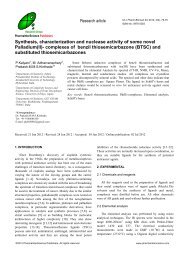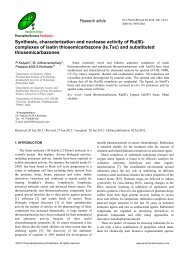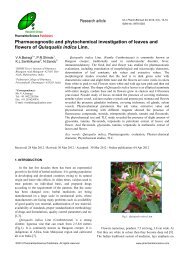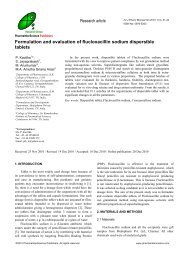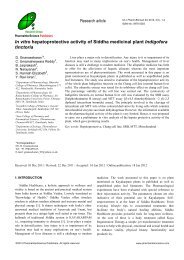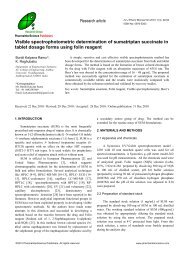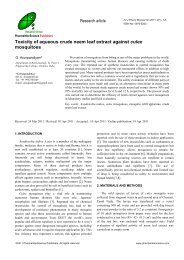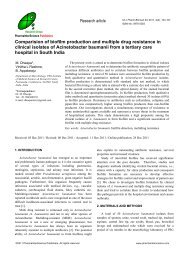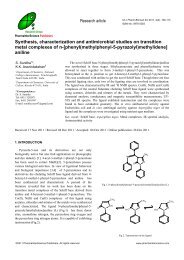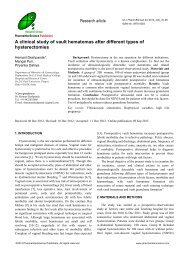Dinesh Kumar Jain et al., Int J Pharm Biomed Sci 2011, 2(2), 55-6056Several HPLC, UV spectrophotometric <strong>and</strong> otherchromatographic <strong>method</strong>s have been reported fordetermination <strong>of</strong> Lornoxicam from pharmaceuticalformulation <strong>and</strong> biological fluids [6]. But none <strong>of</strong> these<strong>method</strong>s demonstrate the simultaneous determination <strong>of</strong> thesetwo drugs in tablets dosage from.This paper describes simple, accurate, precise, <strong>and</strong>sensitive reversed-phase RP-HPLC <strong>and</strong> <strong>HPTLC</strong> <strong>method</strong>s forthe simultaneous estimation <strong>of</strong> LOR <strong>and</strong> PCM in a combinedtablet dosage form.2. MATERIALS AND METHODS2.1 MaterialsLornoxicam <strong>and</strong> paracetamol were obtained fromGlenmark pharmaceutical ltd., Mumbai, as a gratis sample,respectively. HPLC grade chemicals (acetonitrile, methanol<strong>and</strong> water) were obtained from E. Merck (Mumbai, India)The tablet dosage form (Label claim: 8 mg Lornoxicam, <strong>and</strong>500 mg Paracetamol) was procured from the local market <strong>and</strong>other reagents such as chlor<strong>of</strong>orm, acetonitrile, methanol,ethyl acetate <strong>and</strong> ammonia were obtained from E. Merck(Mumbai, India) which were <strong>of</strong> analytical grade.2.2 Apparatus <strong>and</strong> chromatographic conditions2.2.1 HPLC <strong>method</strong>The mobile phase consist <strong>of</strong> acetonitrile: methanol: water(50:30:20, %v/v/v) at a flow rate <strong>of</strong> 1.0 mL/min. Before use,the mobile phase was degassed by an ultrasonic bath <strong>and</strong>filtered using 0.4 μm membrane filter before use. Separationwas performed at room temperature on HPLC system havinga pump (Shimadzu LC 10ATVP ) with 20 µL Rheodyneinjector , Phenomenex Luna C18 (5 µm x 25cm x 4.6mm i.d)column <strong>and</strong> SPD-10 AVP photodiode array (PDA) UV-Visible detector set at 290 nm <strong>and</strong> equipped with CLASS-VPs<strong>of</strong>tware (Shimadzu. Kyoto, Japan).2.2.2 <strong>HPTLC</strong> <strong>method</strong>Chromatography was performed over precoated silica gelaluminum plates 60 F254 (20 × 10 cm, 200 μm thickness; E.Merck, Germany) as stationary phase. Samples were spottedin the form <strong>of</strong> distinct b<strong>and</strong>s (6 millimeter; 10 mm apart) witha CAMAG 100 μL syringe using a Linomat V (CAMAG,Switzerl<strong>and</strong>) sample applicator. Equipment parameters wereoptimized for smooth working (scanning speed 100 nm/sec;slit dimension 6.00 x 0.45 mm). Linear ascendingdevelopment was carried out in a 20 cm × 10 cm twin troughglass chamber (CAMAG, Switzerl<strong>and</strong>) previously saturatedwith optimized mobile phase for 20 min at room temperature(30ºC) <strong>and</strong> relative humidity (RH) <strong>of</strong> 55 ± 5%. The plateswere developed to the distance <strong>of</strong> 10 cm <strong>and</strong> dried using hairdryer. The mobile phase was chlor<strong>of</strong>orm: methanol:ethylacetate: ammonia (2.0:1.5:5.5:1, %v/vv/v) withdensitometric analysis at 290 nm in absorbance mode withCAMAG TLC scanner III <strong>and</strong> winCATS s<strong>of</strong>tware (Ver.1.2.0).2.3 Method <strong>validation</strong>2.3.1 LinearityFor HPLC analysis, the calibration graph was plotted over6 different concentrations in the range <strong>of</strong> 2–10 μg/mL <strong>and</strong> 5-100 μg/mL for LOR <strong>and</strong> PCM. Accurately measured workingst<strong>and</strong>ard solution aliquots <strong>of</strong> LOR <strong>and</strong> PCM were transferredto a series <strong>of</strong> 10 mL volumetric flasks <strong>and</strong> diluted to the markwith mobile phase. Aliquots (20 μL) <strong>of</strong> each solution wereinjected chromatographed in six replicates.For <strong>HPTLC</strong> analysis, a stock solution containing 1000ng/μL each for LOR <strong>and</strong> PCM were prepared in methanol.Different volumes <strong>of</strong> this solution were applied to the plateresulting in application <strong>of</strong> 300-550 ng/b<strong>and</strong> for LOR <strong>and</strong>100-500 ng/b<strong>and</strong> for PCM, respectively (n=6). Peak areaswere plotted against corresponding concentrations to furnishthe calibration plot.2.3.2 PrecisionRepeatability <strong>of</strong> sample application <strong>and</strong> measurement <strong>of</strong>peak areas were assessed by chromatography <strong>of</strong> six replicates<strong>of</strong> the same concentration (300 ng/b<strong>and</strong> for LOR <strong>and</strong> 100ng/b<strong>and</strong> for PCM). Intra-day <strong>and</strong> inter-day precision fordetermination <strong>of</strong> LOR <strong>and</strong> PCM were measured at threedifferent concentration (300, 350, 400ng/b<strong>and</strong>) <strong>and</strong> (100,200, 300ng/b<strong>and</strong>). The intraday <strong>and</strong> Interday precisions <strong>of</strong> theproposed <strong>method</strong>s were determined by analyzing st<strong>and</strong>ardsolution <strong>of</strong> LOR <strong>and</strong> PCM at three different concentrations(4.0, 8.0, <strong>and</strong> 12.0 μg/mL for the HPLC <strong>method</strong> <strong>and</strong> 200,300, <strong>and</strong> 500 ng/b<strong>and</strong> for the <strong>HPTLC</strong> <strong>method</strong>) three times onthe same day <strong>and</strong> on three different days.2.3.3 RobustnessThe robustness <strong>of</strong> the <strong>method</strong> was determined byintroducing small changes in certain chromatographicparameters, such as changing the composition <strong>and</strong> the pH <strong>of</strong>mobile phase in the range ±5%.2.3.4 SpecificityThe specificity <strong>of</strong> the <strong>method</strong> was determined by analysis<strong>of</strong> drug st<strong>and</strong>ards <strong>and</strong> samples. The b<strong>and</strong> for LOR <strong>and</strong> PCMin the sample was identified by comparing the RF value <strong>and</strong>spectrum <strong>of</strong> the b<strong>and</strong> with those <strong>of</strong> the b<strong>and</strong> from a st<strong>and</strong>ard.The peak purity <strong>of</strong> LOR <strong>and</strong> PCM were assessed bycomparing spectra acquired at three different positions on thepeak, i.e. the peak start, peak apex, <strong>and</strong> peak end positions <strong>of</strong>the b<strong>and</strong> [7, 8].©2011 PharmaInterScience Publishers. All rights reserved. www.pharmainterscience.com
Dinesh Kumar Jain et al., Int J Pharm Biomed Sci 2011, 2(2), 55-60Table 1System suitability parameter for HPLC <strong>method</strong>Parameters LOR PCMCalibration range (µg/mL) 2-40 8-150Theoretical plate number 4009 2311HETP a 0.0073 0.004Tailing factor 1.52 1.86Capacity factor (k’) 0 1.78Resolution - 6.58a HETP = Height equivalent to theoretical plate, cmTable 2Summary <strong>of</strong> <strong>validation</strong> dataS. No. Validation parameters Observation <strong>of</strong> <strong>HPTLC</strong> <strong>method</strong>LORPCM1 Linearity range300-550 100-500(ng/b<strong>and</strong>)2 Slope 10.48 4.663 Intercept 1226.7 -137.044 Wavelength (nm) 249 3705 Correlation coefficient 0.993 0.9966 Accuracy (n=5) 100.39±1.42 100.56±1.27 Intraday Precision (n=3) 1971.7±24.85 1356.6±23.378 Interday Precision (n=3) 5376.6±88.37 1361.6±35.549 Repeatability (n=6) 3814.8±66.61 313.88±6.3410 Recovery (n=3) 98.91±1.39 98.84±0.5711 LOD (ng/b<strong>and</strong>) 0.62±0.02 0.92±0.0312 LOQ (ng/b<strong>and</strong>) 1.26±0.01 2.17±0.0213 Robustness Robust Robust14 Specificity Specific Specific2.3.5 Limit <strong>of</strong> detection (LOD) <strong>and</strong> Limit <strong>of</strong> quantitation(LOQ)The LOD with signal-to-noise (S/N) ratio <strong>of</strong> 3:1 <strong>and</strong> theLOQ with S/N ratio <strong>of</strong> 10:1 were calculated for LOR <strong>and</strong>PCM using the following equations LOD = 3.3 σ/S, LOQ =10 σ/S where σ is the st<strong>and</strong>ard deviation <strong>of</strong> the response <strong>and</strong>S is the st<strong>and</strong>ard deviation <strong>of</strong> the y-intercept <strong>of</strong> the regressionline for HPLC analysis. For <strong>HPTLC</strong> analysis the limit <strong>of</strong>detection (LOD) <strong>and</strong> the limit <strong>of</strong> quantification (LOQ) wasdetermined by diluting known concentration <strong>of</strong> st<strong>and</strong>ardstock solution until the average responses wereapproximately 3 or 10 times the responses <strong>of</strong> the blank.2.3.6 RecoveryTo check the recovery <strong>of</strong> the drug at different levels informulations, samples were spiked with 50, 100, <strong>and</strong> 150 %<strong>of</strong> LOR <strong>and</strong> PCM st<strong>and</strong>ards <strong>and</strong> the mixtures were analyzedin triplicate by the proposed <strong>method</strong>.2.4 Stability <strong>of</strong> Sample SolutionsSolutions at two different concentrations (300 <strong>and</strong>350ng/b<strong>and</strong> for LOR <strong>and</strong> 200 <strong>and</strong> 300ng/b<strong>and</strong> for PCM)were prepared from stock solution <strong>and</strong> stored at roomtemperature for 24, 4.0, 2.0 1.0, 0.5 <strong>and</strong> 0.2h. They were thenchromatographed on the same plate. The chromatogramswere evaluated for additional spots if any.2.5 Assay <strong>of</strong> the marketed formulationTwenty tablets were weighed <strong>and</strong> crushed. An amount <strong>of</strong>powder equivalent to 100 mg PCM was transferred to a 100mL volumetric flask <strong>and</strong> extracted with methanol for 30 minby shaking mechanically <strong>and</strong> volume was adjusted to markwith the same solvent. 1mL <strong>of</strong> this solution was diluted to 10mL with methanol. An appropriate volume <strong>of</strong> 5 μL wasassayed by the chromatographic procedure described above.No interferences were observed from the excipientscommonly present in the tablets.2.6 Forced degradation studiesA stock solution containing 10 mg for each (LOR <strong>and</strong>PCM) in 10 mL methanol was prepared. This solution wasused for forced degradation to provide an indication <strong>of</strong> the<strong>stability</strong>-<strong>indicating</strong> property <strong>and</strong> specificity <strong>of</strong> the <strong>method</strong>.The average peak area <strong>of</strong> sex replicates <strong>of</strong> LOR <strong>and</strong> PCM(1000 ng/b<strong>and</strong>) was used for analysis.2.6.1 Acid degradationMethanolic solution <strong>of</strong> each drug (10 mg) was separatelydissolved in 10 mL <strong>of</strong> 1M HCl <strong>and</strong> these solutions were keptfor 8 h at room temperature in dark in order to exclude thepossible degradative effect <strong>of</strong> light. The solutions (1 mL)were taken <strong>and</strong> neutralized <strong>and</strong> then diluted up to 10 mL withmethanol. The resultant solutions were applied on TLC platein triplicate (10 μL each, i.e. 1000 ng/b<strong>and</strong>). The plate waschromatographed as described above.2.6.2 Base degradationMethanolic solution <strong>of</strong> each drug (10 mg) was separatelydissolved in 10 mL <strong>of</strong> 1 M NaOH solution. These solutionswere kept for 8 h at room temperature in dark in order toexclude the possible degradative effect <strong>of</strong> light. The solutions(1 mL) were taken <strong>and</strong> neutralized <strong>and</strong> then diluted up to 10mL with methanol. The resultant solutions were applied onTLC plate in triplicate (10 μL each, i.e. 1000 ng/b<strong>and</strong>). Theplate was chromatographed as described above.2.6.3 Oxidative degradationEach drug (10 mg) was dissolved in 10 mL <strong>of</strong> methanolicsolution <strong>of</strong> hydrogen peroxide (10% v/v) <strong>and</strong> kept for 8 h atroom temperature in the dark, to exclude the possibledegradative effect <strong>of</strong> light. The solution (1 mL) was thendiluted to 10 mL with methanol <strong>and</strong> treated as described foracid <strong>and</strong> base-induced degradation.57©2011 PharmaInterScience Publishers. All rights reserved. www.pharmainterscience.com




